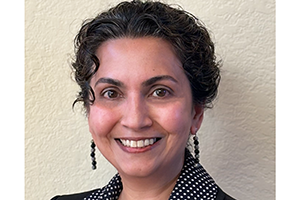You’ve downloaded Zoom. You’ve logged in to your work meeting. You’ve navigated your microphone and video settings and somehow managed to change your background.
Now comes the hard part: communication.
Online group meetings are subject to the same pitfalls and miscommunications of face-to-face groups, perhaps even more so. As the world rushed online to virtual meeting spaces during the coronavirus pandemic, two UWM graduate students began to wonder: How do group conflicts manifest online versus in person? How should group leaders manage those problems?
Communication PhD candidate Jessica Kahlow and her co-author, Hanna Klecka, published a paper earlier this year exploring those questions. Klecka graduated from UWM with her master’s degree in communication this spring. They and their mentor, Erin Ruppel, associate professor of communication, examined existing research about online and face-to-face meeting conflicts and found they needed to account for a new type of group.
“A more appropriate way to address or research these types of groups is actually looking at hybrid groups,” Klecka said. “For the most part, that’s the reality of today’s world, and we’ve seen that in a very aggressive way these past few months.”
Hybrid groups are those that work with a mix of face-to-face and online meetings. For example, a sales team that previously worked together in an office but now hosts meetings online would be considered a “hybrid group.”
By examining hybrid groups, Kahlow and Klecka found some best practices to make online meetings run smoothly. Group leaders should:
Establish set norms from the beginning
“Since there is, perhaps, more ambiguity with what to communicate or how to communicate, or what technology to use to communicate, establishing norms early is imperative because it sets up expectations,” Klecka said.
That might mean laying out rules for when microphones should be muted, for example, or establishing methods to make sure everyone has a chance to talk. With expectations clearly laid out, there will be less chance for conflicts to arise from miscommunications.
Make sure there are clear channels of communication outside of the meetings
“If you’re teaching, for example, you don’t see the students before class or the ones who linger after class,” Kahlow noted. “That happens in the workplace too; the discussions before and after meetings aren’t as common, so it’s important to know who to go to get a response.”
In fact, much of school or workplace dynamics rely on informal meetings in the hallway or popping by a coworker’s cubicle. Without those small, in-person interactions, people need to make an effort to reach out beyond meetings if they have extra questions, Kahlow added.
“Force” meetings if necessary
“Right now, I work as a psychology lab manager. With my lab, we didn’t have a lot of consistent meetings,” Klecka said. “Once things changed, it felt needed to be more proactive in having standing meetings each week. Being proactive in ‘forcing’ communication was a significant change, and that, I think, helped us stay on the same page and not allow for the miscommunication or lack of communication.”
Despite their findings, Kahlow and Klecka agree that more research must be done in this area, especially as the pandemic continues and online meetings become more necessary and commonplace. There is a distinct lack of literature and research concerning hybrid groups, they noted.
That might be a problem for schools as classes resume in the fall. With many institutions, including UWM, relying on online classes, there is plenty of potential for conflicts and miscommunications between teachers and students. Have patience, Klecka urged.
“As someone who has taught online, (I’ve noticed) students don’t ask questions for clarification. In a classroom setting, if one person asks a question, everyone benefits and gets the answer,” she said. “That doesn’t always happen depending on what the class is or how the class is formatted in an online context. So, have patience and be proactive in communicating.”
Kahlow also encouraged students to make use of any “online office hours” that teachers and professors might offer, especially since students won’t be able to informally ask questions before or after class.
And, if conflicts do arise, the answer is simple: more communication.







